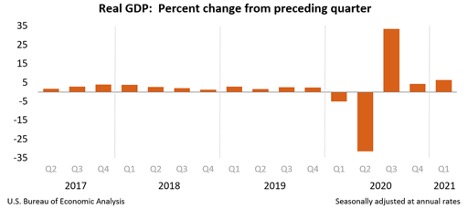eNews May 6
|
In the News
May 6, 2021
Spike in Shipping Mishaps Emphasize the Value
of Solid Incoterms
Annacaroline Caruso, editorial associate
Thousands of shipping containers haven’t made it to their final destination in the past few months. More than 3,000 containers fell overboard last year, and more than 1,000 dropped into the ocean so far this year, the biggest spike in seven years, according to a Bloomberg news report.
The spike in overboard cargo is likely due to multiple factors. Ships are getting bigger and containers are being stacked higher. Combine this with unpredictable weather and the increasing demand for speedy shipping, and it’s no surprise cargo is being lost at sea.
Chris Turberville, head of marine hull and liabilities for the U.K. at Allianz, told American Shipper, “It is very clear that in some shipping segments, loss-prevention measures have not kept pace with the upscaling of vessels.”
So, who assumes the economic loss in these situations? Well, it depends on what Incoterm the buyer and seller negotiated at the beginning of the transaction.
That is one of the primary reasons why it’s so critical for buyers and sellers to agree on clear Incoterms so there’s no question about who pays for what, when risk transfers, or where the goods are to be delivered. Clear Incoterms mean less confusion and less ambiguity in global trade, according to Phillip Poland with DHL Global Forwarding, during a webinar for NACM and FCIB, An Exporter’s Perspective of Incoterms.
“I flew all over the world negotiating contracts and so many times we spent twice to three times as long fighting over Incoterms than we did the price of the goods because it’s the greatest place where you have fluctuation as you start adjusting the risk of loss,” Poland explained.
Incoterms 2020 are clearer than the ones prior and provide more guidance to help buyers and sellers make the best decisions.
“There were many times where customers were picking the wrong term or modifying terms because the term didn’t quite fit their scenario,” Poland said. “[The International Chamber of Commerce] really tried to change up the terms so that there could be a better opportunity to ensure that the right term was being used.”
There are 11 ICC Incoterms that outline the responsibility, risk and cost of each party:
- EXW (Ex Works)
- FCA (Free Carrier)
- FAS (Free Alongside Ship)
- FOB (Free on Board)
- CIF (Cost, Insurance and Freight)
- CIP (Carriage and Insurance Paid to)
- CFR (Cost and Freight)
- CPT (Carriage Paid to)
- DAP (Delivered at Place)
- DDP (Delivery Duty Paid)
- DPU (Delivered at Place Unloaded)
With E and F terms, most of the responsibility and risk falls on the buyer whereas D terms create greater risk for the seller. C terms divvy up the liability somewhat evenly among both parties.
“We’re trying to get the least amount of risk so we’re trying to transfer the sale as soon as possible, as the seller,” Poland said.
CIF and CIP are the only two terms that require the seller to buy insurance. However, for all Incoterm options, insurance comes down to “what you’re willing to pay as a seller or demand as a buyer,” Poland said.
Risk is transferred from the seller to buyer as soon as the goods are delivered. Depending on which Incoterm was agreed upon, the point of delivery could be at the port of loading, the destination terminal, or a place where the goods are unloaded.
The saga of the Ever Given, the vessel that blocked the Suez Canal for six days in March, demonstrates the importance of understanding the transfer of risk and clearly identifying the shipping rules such as ICC Incoterms that are being used. Egyptian authorities are detaining the container ship until a compensation demand is met. In response, the ship’s owner has declared general average. “The law of general average is a principle of maritime law whereby all stakeholders in a sea venture proportionally share any losses resulting from a voluntary sacrifice of part of the ship or cargo to save the whole in an emergency,” according to Wikipedia.
“In essence, it means that everyone with goods on board the vessel must contribute to the vessel owner’s costs at a yet-to-be-determined percentage of each shipment’s value,” wrote Bob Ronai, a member of the ICC Incoterms 2020 drafting group, in a blog.
To determine ownership of each shipment on board, “we need to look at the invoice,” Ronai explained. “It would be an unusual invoice not to mention a trade term by way of a three-letter acronym.” However, Ronai pointed out that it’s common to not reference a definition of the term used.
Although ICC Incoterms are commonly used, “without specifically making reference to these rules, the three-letter abbreviations remain undefined, possibly for lawyers and courts to determine what was intended,” Ronai added.
An Exporter’s Perspective of Incoterms is available on-demand.
Court Supports Pro Landscape USA Lien Claims on Appeal
Bryan Mason, editorial associate
A Utah Court of Appeals decided in the case of Zion Village Resort LLC v. Pro Curb U.S.A. LLC that the order in which information is presented on a preliminary notice is not as important as having all of the necessary information.
Pro Landscape had filed its preliminary notices for the Zion Village condominium project through the Utah State Construction Registry (SCR), as required by state law. Notices such as these in Utah must contain the following information: name, address, telephone number and email of the person providing construction work.
When Pro Landscape filed its notices, it listed “Chad Hansen” under the section titled “Person Furnishing Labor, Service, Equipment or Material.” In the comments section, the company added “services [were] provided by Pro Curb USA LLC DBA Pro Landscape USA.”
After performing work on the development, Pro Landscape ended up filing liens on various parts. When Zion Village searched the databank, the preliminary notices filed by Pro Landscape did not appear because they were filed under Chad Hansen’s name. As a result, Zion Village filed a petition to nullify the liens because the developer claimed the contractor failed to file proper preliminary notices.
A district court sided with Zion Village, stating that because the notices were filed under Chad Hansen, not Pro Landscape, the lien claimant “neglected to include such basic information as the identity of the actual lien claimant.”
The appeals court, however, reversed that decision. Under this ruling, the court concluded that Pro Landscape met the legal requirements for a valid preliminary notice because the state’s construction lien statute mandates the application of a “substantial compliance” standard, not a “strict compliance” standard. All of the necessary information was included in the preliminary notice despite the order in which it was presented.
“While Pro Landscape may have set forth the required information in an unconventional sequence, the preliminary notices it filed contained all statutorily required information,” the court stated.
“So, if there are some inaccuracies in your lien … it may be okay,” said attorney Jason Robinson, founding shareholder and director of Babcock Scott & Babcock P.C., in a recent STS NACM webinar on Utah’s lien laws. As long as your notice documents contain all the required information, you can make a case for this decree, Robinson added. However, there is a large gray area surrounding this rule, which many attorneys may take advantage of, he noted. “There is no definition of what substantial compliance means.”
US Economy Sees Strong Start in First Quarter 2021
Real gross domestic product (GDP) increased at an annual rate of 6.4% in the first quarter of 2021, according to the "advance" estimate released by the Bureau of Economic Analysis. In the fourth quarter of 2020, real GDP grew 4.3%.
The GDP estimate is based on source data that are incomplete or subject to further revision by the source agency. The "second" estimate for the first quarter, based on more complete data, will be released on May 27.

The increase in real GDP in the first quarter reflects increases in personal consumption expenditures (PCE), nonresidential fixed investment, federal government spending, residential fixed investment, and state and local government spending that were partly offset by decreases in private inventory investment and exports. Imports, which are a subtraction in the calculation of GDP, increased.
COVID-19 Impact on the First-Quarter 2021 GDP Estimate
The increase in first quarter GDP reflects continued economic recovery, reopening of establishments, and continued government response related to the COVID-19 pandemic. In the first quarter, government assistance payments, such as direct economic impact payments, expanded unemployment benefits, and Paycheck Protection Program loans, were distributed to households and businesses through the Coronavirus Response and Relief Supplemental Appropriations Act and the American Rescue Plan Act. The full economic effects of the COVID-19 pandemic cannot be quantified in the GDP estimate for the first quarter of 2021 because the impacts are generally embedded in source data and cannot be separately identified.
The increase in PCE reflects increases in durable goods (led by motor vehicles and parts), nondurable goods (led by food and beverages) and services (led by food services and accommodations). The increase in nonresidential fixed investment reflects increases in equipment (led by information processing equipment) and intellectual property products (led by software). The increase in federal government spending primarily reflected an increase in payments made to banks for processing and administering the Paycheck Protection Program loan applications as well as purchases of COVID-19 vaccines for distribution to the public. The decrease in private inventory investment primarily reflected a decrease in retail trade inventories.
Current dollar GDP increased 10.7%, or $554.2 billion, in the first quarter to a level of $22.05 trillion. In the fourth quarter, GDP increased 6.3%, or $324.5 billion. More information on the source data that underlie the estimates is available in the Key Source and Data Assumptions file on BEA's website.
The price index for gross domestic purchases increased 3.8% in the first quarter, compared with 1.7% in the fourth quarter. The PCE price index increased 3.5%, compared with an increase of 1.5%. Excluding food and energy prices, the PCE price index increased 2.3 percent, compared with an increase of 1.3%.
Source Data for the Advance Estimate
Information on the key source data and assumptions used in the advance estimate is provided in a Technical Note that is posted with the news release on BEA's website. A detailed Key Source Data and Assumptions file is also posted for each release. For information on updates to GDP, see the "Additional Information" section that follows.
The frustration is real. You say things, share things and communicate important messages, and it seems to fall on deaf ears. Have you ever wondered why people aren’t listening to you? Have you ever considered that it might not be about them at all?
At the core, effective communication is message sent; message received. Listening is clearly in the middle of that exchange. If we want to get our messages received clearly (another way to say that people are listening to you), we should consider what we are doing to impede the message being received. Which leads to the question: What can I do to make it easier for people to listen to me?
That is a great question. Before we get to the answer, we must acknowledge this profound truth: someone else listening to us isn’t in our control. We can’t “make someone” listen to us—just ask any elementary school teacher on the day before Spring Break starts. Everyone owns their own choice to listen, and so we must determine how to influence, encourage, and persuade them to listen to us.
As we think about that truth—that getting people to listen to us is an exercise in influence, we can quickly identify four things we often do wrong—four things that keep people from listening to us.
You Aren’t Listening to Them
If you aren’t listening to me, why should I listen to you? It may sound petty and adolescent, but our brains all work like that sometimes. One of the best things you can do to improve the chances people will be listening to you is to listen them. Think about your best communication exchanges. In those cases, you are likely intently listening to others and they are doing the same in return. More on that in a minute, but for now realize that it probably isn’t a coincidence.
If people aren’t listening to you stop and ask yourself, am I modelling what I want them to do?
You Aren’t Focused on “Message Received”
Think about the side-by-side talking heads on any TV news or sports talk show. There is lots of talking, and very little listening going on. In those cases, both parties are often talking at the same time, over each other. Not only are they not listening to each other, but if we are the ultimate audience, they are making it hard for us to listen to them too. While our communication situations might not be exactly like that, there are times they are eerily similar. When your focus is on what you are saying, you aren’t thinking about your audience at all.
If you want people to listen more closely to you, shift your focus from “making your point” (which is about pushing your message onto someone), to “helping them see” (which is about aiding them in hearing your point).
You Aren’t Tailoring the Message to Them
Have you ever seen the presentation that you know has been given five (or fifty times) -the one where the presenter seems on autopilot? While they may be polished and well prepared, does it sometimes feel like there might be something missing?
This is another example of the speaker being too focused on their message, and not enough on the audience. Knowing your stuff, having the facts, and even having a good story to tell isn’t enough, if there isn’t a perfect match between that message and the needs and interests of the audience.
Whether your audience is 1 or 100, are you speaking to them? Consider these questions: Are you speaking from your experience, or tapping into theirs? Are you using language and examples that they understand? Are you giving them good reasons, both intellectual and emotional, to listen to you?
Talking louder, or simple repetition won’t solve your problem. If you want others to listen to you, make it easy for them to do so, and give them reasons to. Remember they are deciding whether to listen to you or not, if they aren’t, it is up to you to think about what you can do to capture their interest and change their mind.
You Aren’t Creating a Dialogue
Listening to a lecture is hard. However good the lecture, speech or sermon is, you have an internal dialogue going on, don’t you? You have questions, you’d like to share your thoughts, you’d like the person to slow down or speed up. In other words, when communication is one way, it is harder for it to be successful.
You will create the opportunity and likelihood that others will listen if you stop focusing on your message and engage them in a dialogue about your message. If you feel people aren’t listening, stop talking. Ask a question about their thoughts or feelings. Elicit their questions. As you turn your exchange into a two-way dialogue, the levels of listening by both parties (you too!) will likely increase.
We have all felt the frustration when it doesn’t feel like our communication is working. It is too easy to just blame all of that on the other person. If someone isn’t listening to you, you will get better results if you focus on what you could change that might encourage them to listen to you—which means rather than waiting for them to change, the change must start with us.
© (2021) All Rights Reserved, The Kevin Eikenberry Group. Kevin is chief potential officer of The Kevin Eikenberry Group, a learning consulting company that helps clients reach their potential through training, consulting and speaking services. Sign up for our free leadership series at https://kevineikenberry.com/join-13-days/
|
Upcoming Webinars |
|
May 10 |
Idaho, Residential vs. Commercial Construction is a BIG DEAL Speaker: Chris Ring, NACM Secured Transaction Services |
| International Debt Collection During COVID-19
Speakers: Bart van Onna and Alexandru Buzamet, Bierens Group |
May 11 |
|
May 12 |
Onboarding New Customers – Best Practices for Success
Speaker: Chris Doxey, CAPP, CCSA, CICA, CPC, Doxey Inc. |
| Mechanic’s Lien, Bonds & More Power Tools for Getting Paid in Virginia Speaker: Brian Loffredo, Esq., Offit Kurman, P.A. |
May 19 |


















